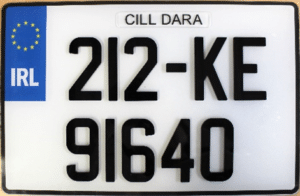The new British Standard (BS AU 145e) for number plate manufacture comes into effect on the 1st September 2021. The primary purpose for updating the standard is to better comply with the readability by ANPR cameras.
By law, all number plate manufacturers must comply with this standard. The current standard, BS AU 145d, will become void. There are new changes that manufacturers will need to know in order to prepare for the standard, starting on the 1st September 2021.
What does BS AU 145e Introduce?
- Characters must be a single tone piano black in Charles Wright font. Two tone and stylized characters such as carbon, 3D effect (also known as shadow), and split digit, are illegal.
- Manufacturers must print the BS AU 145e standard on their plates. BS AU 145d is no longer permissible
- The business and postcode of the manufacturer must be printed alongside the 145e standard. This must be 7mm below the characters of the registration and be between 3mm and 10mm in height
- Nothing can be printed within 10mm of the registration characters, except for the aforementioned standard and manufacturer mark
- A border is optional. It must be 10mm from the registration characters and up to 5mm in thickness.
- A plate lip is optional
- The new standard also highly recommends adhesive pads over self-tapping screws for fixing plates to vehicles as the screws can compromise the plates durability
What are the tests my number plates must pass?
Many of the tests that must be passed are the same as the BS AU 145d standard. The new tests are as follows:
- Abrasion: Plates must be able to withstand dirt, grime, and pressure washing.
- Near Infrared contrast: ANPR cameras read number plates using infrared technology. In order to read a plate correctly, the contrast between the plate background and the digits must be great enough to be visible to the camera
Manufacturers can self-certify their number plates by conducting the tests themselves or they can have their product tested by a third party. As such, it is the manufacturers responsibility to ensure that they are compliant with the new standard.
